A minor magistracy. They were originally two in number, called aedilis plebis. The office was established in the same year as the tribunes of the people (tribunis plebis in 494 BC).

A dispute between patricians and plebes over costs associated with the games led to the introduction of the Curule Aediles (aediles curules). They were also two in number and were originally only allowed to be patrician, though this changed within a year of the office being established. Curule Aediles were of higher rank than Plebeian Aediles and were entitled to two lictors as symbols of imperium, though their responsibilities (especially by the late Republic) were virtually the same. These responsibilities included:
1) City Maintenance: the repair and preservation of temples, sewers and aqueducts; street cleaning and paving; regulations regarding traffic, dangerous animals and dilapidated buildings; precautions against fire; superintendence of baths and taverns; enforcement of sumptuary laws (including moral standards); punishment of gamblers and usurers; including the prevention of foreign superstitions. They also policed ownership and regulation of public lands.
2) Maintenance of city supplies: They insured the quality of imports and the correct quantities by weight and measure standards. They oversaw the purchase of city grain supply.
3) Supervised the games: Organized and maintained the public games at their own expense.
Two patrician aediles, (Cereales) were added in 44 BC by Julius Caesar to specifically monitor the grain supply, but this office, like that of the original 4 aediles, lost most of its significance as anything other than a political stepping stone in the imperial period.


